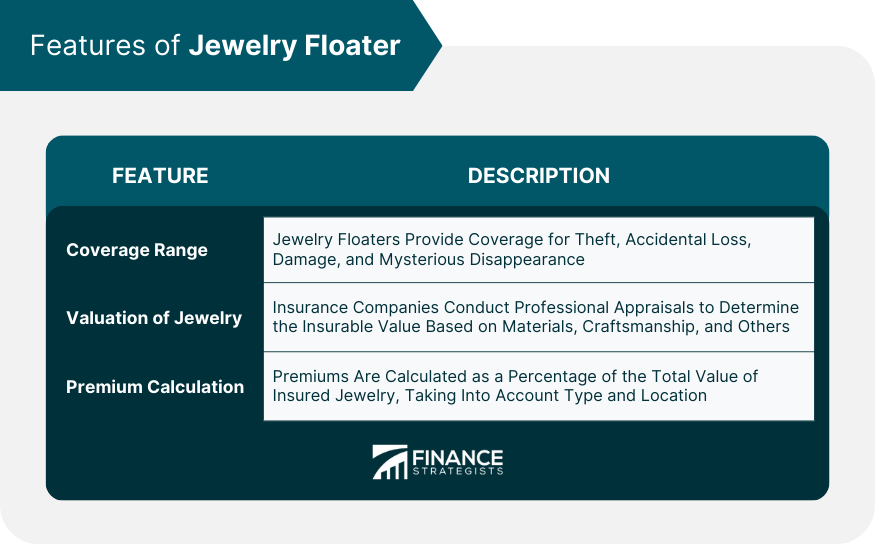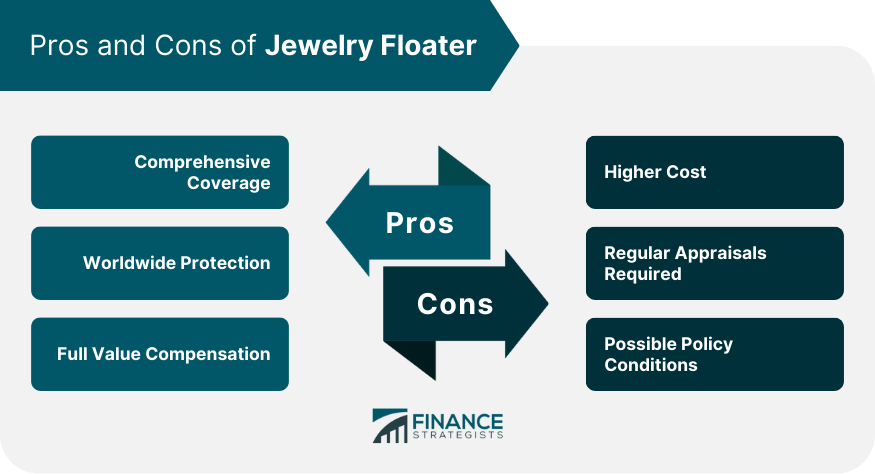A jewelry floater is a type of additional insurance coverage designed specifically to protect valuable pieces like jewelry. Often known as a personal articles floater or jewelry rider, this policy extends beyond the limitations of standard homeowners' or renters' insurance. It covers the full appraised value of your jewelry in events like theft, accidental loss, damage, or even mysterious disappearance. The importance of a jewelry floater arises from the significant monetary and sentimental value of the jewelry. Most standard insurance policies impose a coverage limit for personal property categories, including jewelry, potentially leaving policyholders under-compensated in the event of a loss. A jewelry floater addresses this gap, providing comprehensive coverage and financial protection for valuable pieces and offering peace of mind to the policyholder. A jewelry floater is an endorsement or rider that is added to a standard insurance policy, usually homeowners' or renters' insurance. This addition extends the coverage of the policy to include valuable jewelry items, providing a level of protection that is typically more comprehensive than the standard policy alone. To set up a jewelry floater, each piece to be insured must be professionally appraised to establish its value. The policyholder then pays a premium based on this appraised value and the specific risks covered. If the jewelry is lost, stolen, or damaged, the policyholder can file a claim with the insurance company. If approved, the insurance company will compensate for the loss, usually up to the appraised value of the item, offering financial protection and peace of mind for the policyholder. Jewelry floaters typically provide coverage for a broad range of risks. These may include theft, accidental loss, damage, and even mysterious disappearance. The exact scope of coverage varies by insurer and specific policy. One unique aspect of jewelry floaters is that their coverage is not limited to losses occurring at the policyholder's home. They generally provide worldwide coverage, ensuring protection no matter where the policyholder or their jewelry might be. Insurance companies require an appraisal of each piece of jewelry to determine its insurable value. A professional and certified appraiser typically conducts this process, examining the piece for its materials, craftsmanship, condition, and any other factors affecting its value. It's crucial to understand that the amount paid by an insurance company in the event of a loss may differ from both the market value and the replacement value of the item. The payout is typically based on the appraised value at the time of adding the floater. The premium for a jewelry floater is generally a percentage of the total value of insured jewelry. It can vary based on factors such as the type of jewelry, its appraised value, and where the policyholder lives. The first step to securing a jewelry floater is to find an insurance provider that offers this type of coverage. This may be your existing homeowners or renters insurance company or a specialist insurer focusing on high-value items. Before applying for a jewelry floater, each piece of jewelry that you wish to insure needs to be professionally appraised. This process establishes the item's value, which is essential for determining the coverage amount and premium. Photographing and documenting each piece of jewelry provides a visual record that can be useful in case of loss, theft, or damage. This documentation, combined with the appraisal report, forms the basis of the jewelry floater policy. Once the preliminary steps are completed, the policyholder can apply for the jewelry floater, providing all necessary documentation and information. The insurer may ask for details about where and how the jewelry is stored or worn. After the application, the insurer will review the submitted details and calculate the premium. If the application is approved, the insurer will issue the policy document outlining the terms of the coverage. You should make a claim as soon as possible after noticing that your jewelry is lost, stolen, or damaged. It's essential to report thefts to the police promptly, as insurers often require a police report when processing a claim. The first step in making a claim is to notify your insurance company about the loss. You'll need to provide a detailed account of what happened and submit any supporting documentation, such as a police report or photos. The insurer will then review your claim, which may involve investigating the circumstances of the loss and evaluating the documentation. If the claim is approved, the insurer will pay out up to the appraised value of the jewelry as specified in the policy. Value of Jewelry: If your jewelry's total value exceeds the personal property limit of your standard insurance policy, a jewelry floater can offer the extra coverage needed to protect your investment. Risk of Loss or Damage: Consider your lifestyle and how frequently you wear the jewelry. If your pieces are often exposed to situations where they could be lost or damaged, a floater provides essential protection. Cost of Premiums: Evaluate whether the cost of the additional premium fits within your budget. Premiums are generally a percentage of the total value of insured jewelry. Travel Considerations: If you frequently travel with your jewelry, the worldwide coverage offered by a jewelry floater might be a significant benefit. Policy Terms and Conditions: Look closely at the policy's terms and conditions. Some policies may require specific storage conditions or security measures for the insured items. Comprehensive Coverage: A jewelry floater offers more extensive coverage than standard insurance policies, protecting against theft, loss, and damage of valuable jewelry. Worldwide Protection: Unlike regular policies, the coverage is not limited to your home. It offers protection regardless of where the loss or damage occurs. Full Value Compensation: Jewelry floaters typically cover the full appraised value of your jewelry, ensuring you receive proper compensation in the event of a loss. Higher Cost: The premiums for a jewelry floater can be substantial, particularly for very valuable items. These additional costs can make it less affordable for some individuals. Regular Appraisals Required: To ensure accurate coverage, regular appraisals of your jewelry are necessary, which can be time-consuming and costly. Possible Policy Conditions: There may be conditions attached to the policy, like requiring a home safe for storage or alarm systems, and imposing additional expenses. Jewelry floaters offer an invaluable avenue for safeguarding your prized jewelry pieces against potential risks such as theft, loss, and damage, extending beyond the scope of standard insurance policies. These policies cover the full appraised value of your items, offering worldwide protection that's not restricted to your home. However, deciding to purchase a jewelry floater necessitates careful consideration of various factors, including the value of your jewelry, the risk of loss, premium costs, travel habits, and specific policy terms. While these policies come with an additional cost and may require regular appraisals, the peace of mind and financial protection, they provide can be significant. Therefore, it's crucial to evaluate your personal circumstances and needs carefully when deciding on securing a jewelry floater policy for your valuable pieces.What Is a Jewelry Floater?
How a Jewelry Floater Works
Features of Jewelry Floater
Coverage Range of a Jewelry Floater
Types of Incidents Covered
Geographical Coverage
Valuation of Jewelry
Appraisal Process
Market Value vs Replacement Value
Premium Calculation

Process of Getting a Jewelry Floater
Choose the Right Insurance Provider
Preparatory Measures to Take
Get an Appraisal
Take Photos and Document Jewelry
Apply for a Jewelry Floater
Post-application Expectations

Claiming on a Jewelry Floater Policy
When to Make a Claim
Steps in Making a Claim
Claims Assessment Process
Factors to Consider When Deciding to Get a Jewelry Floater

Pros and Cons of Jewelry Floater
Pros
Cons

Final Thoughts
Jewelry Floater FAQs
A jewelry floater is a type of additional insurance policy specifically designed to cover valuable items like jewelry. It offers broader and more comprehensive coverage compared to standard homeowners or renters' insurance policies, covering the full appraised value of the jewelry.
You should consider getting a jewelry floater if you own valuable jewelry that exceeds the coverage limit of your standard insurance policy. The jewelry floater will provide additional coverage, protecting you from financial loss in case of theft, damage, or loss.
A jewelry floater provides comprehensive coverage for specific items, covering a broader range of incidents, including theft, accidental loss, damage, and even mysterious disappearance. Additionally, a jewelry floater typically provides worldwide coverage, not limited to losses occurring at the policyholder's home.
The premium for a jewelry floater is generally a percentage of the total value of the insured jewelry. Factors such as the type of jewelry, its appraised value, and the location of the policyholder can influence the premium.
If you need to make a claim on your jewelry floater, notify your insurance company as soon as possible after noticing your jewelry is lost, stolen, or damaged. Provide a detailed account of what happened, and submit any supporting documentation, such as a police report or photos.
True Tamplin is a published author, public speaker, CEO of UpDigital, and founder of Finance Strategists.
True is a Certified Educator in Personal Finance (CEPF®), author of The Handy Financial Ratios Guide, a member of the Society for Advancing Business Editing and Writing, contributes to his financial education site, Finance Strategists, and has spoken to various financial communities such as the CFA Institute, as well as university students like his Alma mater, Biola University, where he received a bachelor of science in business and data analytics.
To learn more about True, visit his personal website or view his author profiles on Amazon, Nasdaq and Forbes.











